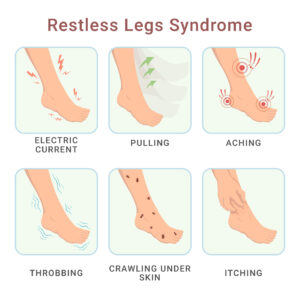Restless Leg Syndrome (RLS) is a disorder that causes an overwhelming urge to move one’s legs and affects 5-10% of adults in the United States1. It typically occurs in the evening or with relaxation. People who suffer from restless leg syndrome describe it as an irresistible urge to get up and move or shake their legs to alleviate the buzzing, tingling, crawling, and restlessness that occurs. For many years, doctors have thought that restless leg syndrome is exclusively a neurological condition. However, several studies over the last 10 years point to venous disease as highly associated with RLS.
How Does Vein Disease Cause Restless Leg Syndrome?
Healthy veins have valves that prevent the backward flow of blood down into your legs. Vein disease is caused by faulty vein valves that allow backward leakage of blood. Backward blood flow causes your veins to enlarge, bulge, and twist resulting in leg symptoms including restless legs. You do NOT have to have bulging varicose veins to have significant, life-style limiting symptoms including restless legs. Vein disease may or may not be associated with varicose veins, spider veins, skin changes and venous ulcerations, or restless legs and indiscriminately affects between 30–40 million Americans.














